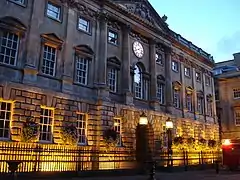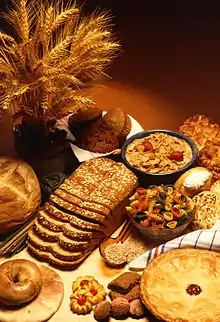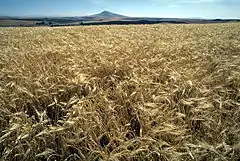Corn exchange
A corn exchange is a building where merchants trade grains. The word "corn" in British English denotes all cereal grains, such as wheat and barley; in the United States these buildings were called grain exchange. Such trade was common in towns and cities across England until the 19th century, but as the trade became centralised in the 20th century many such buildings were used for other purposes. Several have since become historical landmarks.
In the United States, the Minneapolis Grain Exchange is still used to manage the commodities and futures exchange of grain products.
History in England
Corn exchanges were initially held as open markets normally controlled by the town or city authorities. Dedicated corn exchanges start appearing in the earlier part of the 18th century, increasing greatly following the repeal of the Corn Laws in 1846. They declined after the Great Depression of British Agriculture in the late 19th century, and many exchange buildings were converted for other civic uses.
List of corn exchanges
Australia
Canada
Ireland
- The Corn Exchange, Dublin, a Commedia dell'arte theatre company founded in 1995 in Dublin.
The Corn Exchange, Athy, Kildare, now a court house.
United Kingdom
See also: Corn Exchanges in England
.jpg.webp)
- The Exchange, Bristol
- Bishop's Stortford Corn Exchange
- Bury St Edmund’s Corn Exchange
- Corn Exchange, Bedford
- Corn Exchange, Blandford Forum. See The Corn Exchange
- Corn Exchange, Brighton. See Brighton Dome
- Corn Exchange, Camborne
- Cambridge Corn Exchange
- Corn Exchange, Chichester
- Cimla Corn Exchange, Neath
- Cupar Corn Exchange
- Dalkeith Corn Exchange
- Corn Exchange, Devizes
- Corn Exchange, Exeter
- Doncaster Corn Exchange (linked to the main Market Hall)
- Edinburgh Corn Exchange
- Corn Exchange, Haverhill
- Corn Exchange, Hitchin
- Corn Exchange, Ipswich[1]
- Palace Theatre (Kilmarnock), originally opened as a Corn Exchange in 1863
- Corn Exchange, King's Lynn
- Corn Exchange, Kirkcaldy
- Leeds Corn Exchange
- Leicester Corn Exchange
- Corn Exchange, Lewes
- Corn Exchange, Lichfield
- Lincoln Corn Exchange
- Liverpool Corn Exchange
- London Corn Exchange on Mark Lane, the UK's primary agricultural exchange, which later became part of Liffe.
- Corn Exchange, Maidstone (see the Hazlitt Theatre)
- Corn Exchange, Manchester
- Market Rasen Corn Exchange
- Newark-on-Trent Corn Exchange
- Corn Exchange, Newbury
- Corn Exchange, Newport
- Corn Exchange, Preston
- Corn Exchange, Rochester
- Corn Exchange, Sheffield
- Corn Exchange, Sleaford
- St Ives Corn Exchange
- Corn Exchange, Tonbridge
- Corn Exchange, Tunbridge Wells
- Corn Exchange, Wallingford
- Corn Exchange, Winchester
- Corn Exchange, Witney
See also
References
- "Ipswich Corn Exchange, Ipswich". remotegoat.com. Archived from the original on 18 March 2014. Retrieved 22 September 2014.


